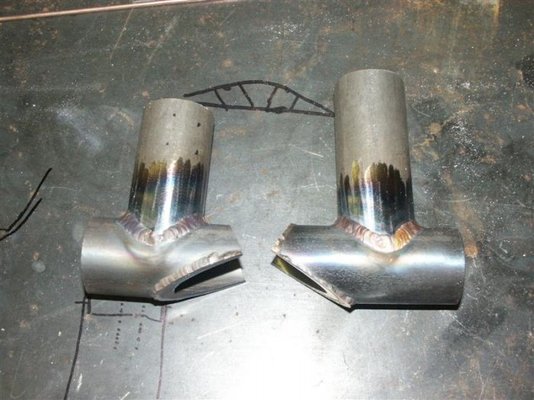You are using an out of date browser. It may not display this or other websites correctly.
You should upgrade or use an alternative browser.
You should upgrade or use an alternative browser.
Another question
- Thread starter buff
- Start date
madkayaker
Pro sparkey Pro Welder
- Messages
- 13,678
yes its called TIG welding  . What you planing
. What you planing 
 . What you planing
. What you planing 
Paul.
Moderator
- Messages
- 7,047
- Location
- Northampton. UK
Tig brazing actually!, you need a silcon bronze filler rod, no flux, don't try it with brazing rods designed for oxy acetylene as they contain zinc, Its a DC process and needs a bit of a knack to melt the rod without melting the parent material.
madkayaker
Pro sparkey Pro Welder
- Messages
- 13,678
sounds fun what would you use it on? Will it work on ali?
madkayaker
Pro sparkey Pro Welder
- Messages
- 13,678
no its a canoe
- Messages
- 13,572
- Location
- England
Tig, using silicon bronze,copper silicon, aluminium silicon rods, is brazing.Different rods for different jobs, silicon bronze is the most common for brazing id say.
Have a look at SIF for rod selection
Have a look at SIF for rod selection
Im making a new tank for my bike, but want to add braze on the inside of the welds for added piece of mind. Contacted my local steel stockist last week about the price of sif rods, and the quoted me nearly £50 for a 1kg pack
Solder.
Well, if you want.
But, solder paint on the seam and warm it up with a blowtorch seems like less hassle.
Since you have to make the top and then weld the tunnel (or base) into the tank, none of this is any good anyway as you can't have the braze (solder, whatever) where you weld the tunnel in. Which is where its most likely to leak...
It's easy enough to TIG up any pinholes, simple water testing usually does the trick for finding them. But it you have a pinhole and the back is brazed or even soldered, good luck with trying to seal that up with a TIG torch.
Alternatively, there's things like POR 15 and other tank sealers on the market that are designed for just this eventualtity.
But, solder paint on the seam and warm it up with a blowtorch seems like less hassle.
Since you have to make the top and then weld the tunnel (or base) into the tank, none of this is any good anyway as you can't have the braze (solder, whatever) where you weld the tunnel in. Which is where its most likely to leak...
It's easy enough to TIG up any pinholes, simple water testing usually does the trick for finding them. But it you have a pinhole and the back is brazed or even soldered, good luck with trying to seal that up with a TIG torch.
Alternatively, there's things like POR 15 and other tank sealers on the market that are designed for just this eventualtity.
Shox Dr
Chief Engineer to Carlos Fandango
- Messages
- 17,986
- Location
- East Yorkshire
I had a play last night and cut though the weld today, there was porosity in some of the weld, I suspected this as you could hear the Rod (braze) boiling with the set at around 45/50Amps.
So I have another go but with a bit of pulse on, this made a big difference.
Still needs some fine tuning
The tube is 32x2.35mm CFS360 NBK you can see where I reused the bits I cut through.
Pulse Amps 50
Base Amps 18
180 Hz
.4sec Pulse Width
1.6mm Red
15CFM
suggestions comments please
So I have another go but with a bit of pulse on, this made a big difference.
Still needs some fine tuning
The tube is 32x2.35mm CFS360 NBK you can see where I reused the bits I cut through.
Pulse Amps 50
Base Amps 18
180 Hz
.4sec Pulse Width
1.6mm Red
15CFM
suggestions comments please
Shox Dr
Chief Engineer to Carlos Fandango
- Messages
- 17,986
- Location
- East Yorkshire
It's hard to tell with a hood on, I treated it a bit like solder, in that the rod would melt/flow when it touched the tube, I just kept upping the amps until I was happy with what I was seeing, and that was the open tube was starting to just wetup, at this point the main tube would take the rod, I need to cut these apart and do a few tests on them before I'm happy that I've got it right, and the joint is strong.
I was hoping Hotrodder, Blackjack to name a couple might have commented. There's very little info out there regarding this process
I was hoping Hotrodder, Blackjack to name a couple might have commented. There's very little info out there regarding this process
Paul.
Moderator
- Messages
- 7,047
- Location
- Northampton. UK
It looks like you've got it about right, well done, the heat in the plate is what melts the rod, the trick as you have found is melting the rod without boiling it, and without melting the parent material, I had to make a load of plaques for a local artist, steel plates with latin wording machined in with the cnc mill, then the letters filled in with bronze, after welding the plate was flash ground to clean up, thats when your imperfections show up..







